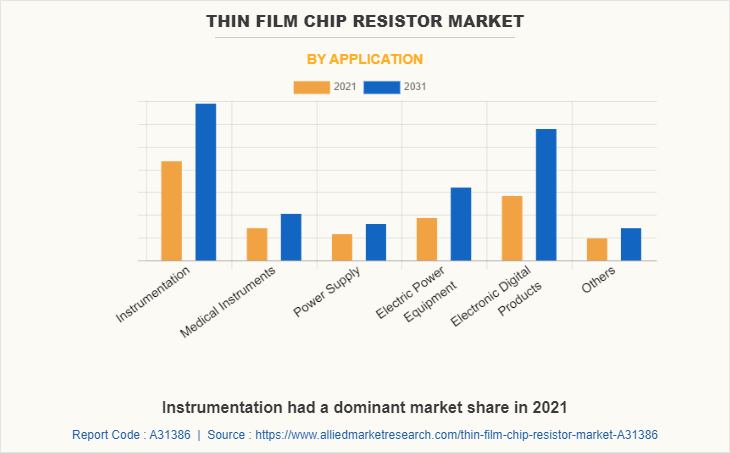Thin Film Chip Resistor Market Research, 2031
The global thin film chip resistor market was valued at $631.2 million in 2021 and is projected to reach $1.1 billion by 2031, growing at a CAGR of 5.4% from 2022 to 2031.
Thin film chip resistors or metal film chip resistors are surface-mounted integrated circuit (IC) devices that offer a known resistance to any electrical current flowing through them. They are available in rectangular or square chip packages and are extremely compact surface-mounted electronic components. They are used to operate, safeguard, and control circuits. Thin film chip resistors may have a set resistance value or a variable or adjustable chip resistance value within a particular range. Chip resistors, also known as surface-mount devices or SMD resistors, are widely used in applications such as automotive and transportation, consumer electronics, industrial, IT, and telecommunications.

Electronics is used in automobiles with technological advancements such as advanced driver assistance systems, electric power steering, infotainment systems, and others to include a better experience and make automobiles safer. The thin film chip resistors are used in circuits to manage the electric current supply to operate the device or system efficiently. The increased usage of electronics in vehicles is driving the thin film chip resistor market growth.
However, a lack of profit due to price decreases and the development of new technologies to replace the thin film chip resistor will hinder the thin film chip resistor market share growth. The market's growth is likely to be hindered by a lack of profit margins as a result of the lower prices for the thin chip resistor products. Another issue restricting market growth is the current development of technologies that can be utilized as a low-cost alternative for the products.
Technological advancements and progress in the healthcare sector, such as the emergence of new mobile health technologies known as mHealth, wearable and wireless devices for patient identification, ECG devices, and detection monitors that have thin film chip resistors in them for limiting current flow and maintaining frequency are factors that drive the chip resistor market. Additionally, robots have made regular medical processes safer, such as spraying disinfectants and performing diagnostics. As a result, technical innovation and advancement in the healthcare sector are opportunities to grow the thin film chip resistor market.
Segment Overview
The thin film chip resistor market is segmented into Type, Application, and End-User.
By type, the Ultra Precision 0.05% Tolerance sub-segment dominated the market in 2021. Ultra-precision 0.05% tolerance is a new phrase in the thin film chip resistors industry that has grown in popularity among both customers and producers in recent years. The primary driver of the growth is its applicability across a wide range of end-use sectors, including healthcare, consumer electronics, automotive, aerospace & military, and solar. These are predicted to be the major factors affecting the thin film chip resistor market size during the forecast period.

By application, the instrumentation sub-segment dominated the global thin film chip resistor market share in 2021. The thin film chip resistor applications for instruments such as precision resistors, potentiometers, and thermometers include consumer electronics, medical devices, and telecommunications equipment. Due to its high degree of accuracy and thin profile design, which makes it particularly suitable for packaging purposes, it is used in electronic digital applications, including smartphones among others. Such applications of thin film chip resistors in the electronics sector are bound to create a scope of growth for the sub-segment during the forecast period.

By end-user, the industrial equipment sub-segment dominated the global thin film chip resistor market share in 2021. Long-term reliability of thin film chip resistors in a low sulfur environment is becoming increasingly important in a wide range of industry categories, including industrial equipment. The benefits of industrial equipment for data/storage centers, server farms, and the IT industry, in general, are enormous in these mission-critical applications, such as banking, mass data storage, military, and especially harsh industrial environments or geographic locations such as China and India, where conditions might not always be ideal for server operation.

By region, Asia-Pacific is anticipated to show the fastest growth by 2031. Asia-Pacific has a significant market share in the global thin film chip resistor market. This is due to increased technological advancements in developing nations such as India, China, and Japan. The increase in urbanization in Asia-Pacific developing countries drives the demand for smart electronic devices and products, boosting the growth of the thin film chip resistors market. The key factor driving the growth of the Asia-Pacific Thin Film Chip Resistor Market Opportunity is the increased usage of technology in electronic devices used in healthcare, digital manufacturing, and the military.

The key players profiled in the thin film chip resistor industry report include Elektronische Bauelemente GmbH (EBG), Ever Ohms Technology Co., Ltd., KOA, Panasonic, Ralec Electronics Corp., Rohm Co., Ltd., Samsung Electro-Mechanics, Ta-I Technology Co., Ltd., Tateyama Kagaku Industry Co., Ltd., and Uniohm.
The global thin film chip resistor industry is segmented based on type, application, end-user, and region. By type, the market is sub-segmented into Ultra Precision 0.05% Tolerance, 0.1% Tolerance, 1% Tolerance, and Others. As per application, the market is classified into instrumentation, medical instruments, power supply, electric power equipment, electronic digital products, and others. According to end-users, the market is classified into industrial equipment, consumer electronics, and others. Region-wise, the market is analyzed across North America, Europe, Asia-Pacific, and LAMEA.
Key Benefits For Stakeholders
- This report provides a quantitative analysis of the thin film chip resistor market forecast, segments, current trends, estimations, and dynamics of the thin film chip resistor market analysis from 2021 to 2031 to identify the prevailing thin film chip resistor market opportunities.
- The market research is offered along with information related to key drivers, restraints, and thin film chip resistor market opportunities.
- Porter's five forces analysis highlights the potency of buyers and suppliers to enable stakeholders to make profit-oriented business decisions and strengthen their supplier-buyer network.
- An in-depth analysis of the thin film chip resistor market segmentation assists in determining the prevailing thin film chip resistor market opportunity.
- Major countries in each region are mapped according to their revenue contribution to the global thin film chip resistor market outlook.
- Market player positioning facilitates benchmarking and provides a clear understanding of the present position of the market players.
- The report includes an analysis of the regional as well as global thin film chip resistor market trends, key players, market segments, application areas, and market growth strategies.
Thin Film Chip Resistor Market Report Highlights
| Aspects | Details |
| Market Size By 2031 | USD 1.1 billion |
| Growth Rate | CAGR of 5.4% |
| Forecast period | 2021 - 2031 |
| Report Pages | 280 |
| By Type |
|
| By Application |
|
| By End-User |
|
| By Region |
|
| Key Market Players | Cal Chip Electronics Inc., asj pte ltd, Ohmite Manufacturing Co., KOA Speer Electronics Inc., Susumu Co., Ltd., International Manufacturing Services Inc., yageo, Viking Tech Corporation, Micro Ohm Corp., Hong Kong Resistors Manufactory, Bourns Inc, Mini Systems Inc. |
Analyst Review
The demand for electronics such as smartphones as well as the expansion of applications such as the Internet and cloud computing are expected to drive the growth in the global thin film chip resistor market. The adoption of new technologies such as artificial intelligence (AI) in products and 5G networks as well as significant expansion in automotive and industrial electronics are likely to be important driving factors in the market. However, raw material price changes are projected to restrict global market growth during the forecast period. Raw materials used in chip resistors, such as ruthenium and palladium, continue to show price volatility and are predicted to have an ongoing impact on chip resistor manufacturing cost. The global thin film chip resistor market is rapidly expanding as a result of developments in emerging technologies such as electric and automated cars, 5G, and the Internet of Things (IoT). The Internet of Things will be a major factor in the growing opportunity of technology.
Among the analyzed regions, North America is expected to account for the highest revenue in the market by the end of 2031, followed by Asia-Pacific, Europe, and LAMEA. The rising adoption of high-end technology based devices are the key factors responsible for the leading position of North America and Asia-Pacific in the global thin film chip resistor market.
The increasing demand for miniaturised and high-precision devices across various applications, as well as the developing trend of the Internet of Things (IoT) and smart homes, can be attributed to the market's growth. In addition, the development of data center infrastructure is expected to provide opportunities for the market development during the forecast period.
Industrial equipment sub-segment of the end-use industry acquired the maximum share of the global thin film chip resistor market in 2021.
Asia-Pacific will provide more business opportunities for the global thin film chip resistor market in future.
The global thin film chip resistor market was valued at $631.2 million in 2021, and is anticipated to reach $1,046.4 million by 2031, growing at a CAGR of 5.4% from 2022 to 2031.
Elektronische Bauelemente GmbH (EBG), Ever Ohms Technology Co., Ltd., KOA, Panasonic, Ralec Electronics Corp., Rohm Co., Ltd., Samsung Electro-Mechanics, Ta-I Technology Co., Ltd., Tateyama Kagaku Industry Co., Ltd., and Uniohm are the major players in the thin film chip resistor market.
Loading Table Of Content...



